How to Dive a Wreck: The Spiegel Grove
The feelings divers get from shipwrecks run the gamut from anticipation to nostalgia and downright awe. So it's no wonder a hearty diving business blooms anywhere you can find a good selection of diveable ships. But the unnatural nature of a shipwreck that makes them so attractive also makes them less accessible than your average reef. Deep, rough, current-swept waters are not the exception, they're the norm, and for this reason many dive shops limit who can join their wreck charters. And they expect the divers who do make the cut to have a certain amount of confidence and skill with the diving techniques often necessary for wreck diving. This month we're going to take you step-by-step through the techniques you need for successful wreck diving using the Spiegel Grove, which lies offshore of Key Largo, Fla., as an example.
Experience Required
Most wrecks are advanced dives, and dive operators will often want to make sure you're comfortable with deep dives and less-than-perfect conditions before they'll sign you up. An advanced-open-water certification or a logbook showing a recent history of similar dives will usually get you an OK. Some operators may require divers to do a shallow-water reef trip before an advanced wreck charter as a checkout dive. Or if you're a beginning or out-of-practice diver who needs a little help, you can usually hire one of the shop's divemasters to guide you and help keep you safe on these advanced dives.
The Boat Ride Out
Wrecks often lie in open water — the Spiegel Grove is six miles offshore — so the chances of rough seas are decent. Set up your gear before leaving the dock or early on in the trip out so you're not fumbling on a bouncing deck at the site. Put your wetsuit on halfway, as well as your boots if you have them, stow your gear bag somewhere out of the way, place your mask, fins and any other equipment you'll need on the dive under the bench at your tank. If you don't already have a buddy, talk to the divemaster after the boat briefing to make sure you know whom you're diving with. Then get together and take advantage of the drive time to discuss your dive plan.
Getting In And Down
The most difficult entries take place in a combination of current and heavy seas, and trying to descend without a line in a stiff current is a good way to get swept away. Most boats use a combination of the following lines to get you from the stern of the dive boat to the deck of the shipwreck.
Trail line This has one end tied to the stern with about 50 feet of line tossed out behind the boat and a float attached to the other end. The current will carry the float out behind the boat so divers will have a line to hold onto when they jump in.
Tag line AKA a granny line, this runs from the stern of the boat to the mooring line. There are two setup variations. The more common runs along the water's surface. The second, often used in rough conditions, is a weighted descent line on the stern of the dive boat with the tag line also attached to the weight and running to the mooring underwater.
Mooring line This is the divers' lifeline between the dive boat and the shipwreck. Always start and end the dive here.
Equipment-donning procedures vary among dive boats, so put your BC, mask and fins on according to the divemaster's instructions. Before moving to the entry point, put some air in your BC and your regulator in your mouth. Enter the water as instructed by the crew as soon as you get to the entry point — a swim step is a precarious place to stand in rough conditions. Once you've splashed, give an overhead OK, move swiftly away from the entry area and grab the trail line so you don't drift in the current.
Once you and your buddy are both in the water and ready to go, use the trail line to pull yourself to the tag line, avoiding the entry area as much as possible. If the current is fairly strong, be sure to never let go of one line without first grabbing another. In this way move yourself to the tag line and pull your way toward the bow. If the boat is swinging, be careful of the hull as you move alongside — holding the tag line and swimming slightly away from the dive boat can help you keep your distance. Once you've made it to the mooring line, hold it with one hand (gloves are a good idea as hydroids, barnacles and fibers from the rope can irritate your hands), and dump your air with the other. Stay with your buddy and go hand-over-hand down the mooring until you get to the wreck.
Getting Around
Mark your starting point • On the Spiegel Grove, you'll notice that some of the mooring lines split in two directions. The line with the steepest angle toward the bottom goes to the sand; the other line — identified by plastic blue marker arrows — will take you to the wreck. Not all wreck moorings are like this, but this is the type of information you should get from your divemaster before you go in. At the bottom, a lot of mooring points look similar, so before you leave your mooring, look around for features on the wreck you'll recognize on the way back. Many experienced divers even bring a small length of brightly colored line to tie on or near their mooring line for positive identification at the end of the dive. Avoid plastics. And be sure to remove the marker on your way back to the surface.
Know the current • Most wrecks lie in open ocean where currents rip more often than not. Find out from the divemaster, or by watching the boat's trail line, the general direction of the current and incorporate that into your dive plan. Also, realize that currents can change quickly anywhere, so always take note of the current's direction once you're on the wreck, and plan your dive conservatively in case it changes during the dive.Once you arrive on the wreck, you can actually use the current as a tool in many cases by turning your dive up current from your exit point. Use the wreck to your advantage by staying on the leeward side or ducking behind towers or equipment on the deck that will provide a buffer for the flow as you swim away from the mooring line. Then explore the current-swept parts of the wreck as you let the current propel you back to your exit point at the end of the dive. Just be sure to stay close enough to the wreck that you don't get swept away.
On the Spiegel Grove, the current typically approaches from the south, hitting the starboard corner of the stern and flowing diagonally across the ship. When the current approaches from this direction, you can dive the rear of the superstructure by using the cranes and other equipment on the deck to protect you from the brunt of the current. This equipment will catch most of the flow and push it up over the top of the ship, so duck down low to the deck to stay out of it. The current will be strongest along the starboard side of the wreck because when the flow hits the back corner of the ship, it flows like a river down the smooth side towards the bow. The port bow area and most of the port side of the superstructure is in the lee, protected from the flow, making these much more relaxing areas to dive.
Going inside? • The great allure for many wreck divers is not swimming the decks. The interiors of these ships offer a three-dimensional experience filled with history and excitement — and a lot of risk. Closed rooms and passageways shouldn't be penetrated unless you have the proper training. Most wreck fatalities — around 92 percent — happen within 50 feet of the exit, so even if it seems like there's plenty of light coming through the entrance, don't go in unless the water inside is clear and you physically see the exit on the other side — for example, wide-open rooms or hallways that are open on both ends. And if you are going to penetrate these areas, look around first and think three-dimensionally while you do it. Look up to make sure you don't swim beneath fishnets, dangling lines or rigging that can entangle your tank valve or other pieces of equipment.
Here are the dos and don'ts of light penetration:
-
Never enter the wreck with less than two-thirds of your air supply.
-
The water inside the structure should be clear and you should see daylight clearly at the exit — even before you enter the passage.
-
Never swim into areas that will keep you in the overhead environment for more than 40 or 50 feet (unless of course you have the proper training and equipment for wreck penetration).
-
Never swim through areas where you and your buddy cannot swim side by side.
The Spiegel Grove's bridge, which you'll find at the forward part of the superstructure, is one of these simple linear swim-throughs, and it's relatively safe for recreational divers to penetrate. Look through the passageway, and you'll clearly see the opposite opening. Once you swim inside, you'll see two companionways running aft from the bridge. It's tempting to enter side passageways like these. Avoid the temptation. Again, if you really want to see the deep, dark bowels of shipwrecks, learn to do it properly with a reputable training agency. If you're not keen on penetrating wrecks, no worries, you can always just stick your head inside and take a look.
Getting back to the mooring • Two factors should limit your wreck dives: the no decompression limit and your available air supply. Manage both using the rule of thirds. You should use a third of your available time limit or air — whichever comes first — to swim away from your exit point, a third to return to the exit point and a third for delays or emergencies. If you plan your dive around the wreck's key structures, use the current to your advantage and limit your dive to a reasonable range, you should have no problem reaching the mooring line ahead of schedule with seven to eight minutes of no-decompression and useable air time remaining. Once you make it back to your starting point, use any remaining time to explore around the mooring, keeping the mooring line clearly in sight until it's time to go up.
Safety Stops
As you approach the 15-foot mark, you should make a safety stop for three to five minutes. This can be a little challenging on a crowded boat if there are a lot of divers hanging on the line at the same time. The goal is to be around 15 feet, but most experts agree that anywhere from 10 to 20 feet is acceptable, so you can spread out within that depth range. On a crowded safety stop, many advanced divers will use a short length of line called a jon line to move away from the actual mooring while still maintaining contact. These are usually between six and 10 feet long, with a clip that slips around the boat's mooring line and locks into place so a diver can back away, leaving space for other divers.
Once you've completed your safety stop, surface and use the tag line to move to the dive boat's stern, or just let the current take you to the trail line. Once you grab the trail line, continue down current so you're out of the exit area, inflate your BC and wait for your turn to exit.
Getting Back Aboard The Dive Boat
In rough conditions, this can be one of the most dangerous parts of the dive. It's best to keep your regulator in your mouth and your mask firmly on your face until you're aboard the boat and away from the entry area. Some vessels have fins-on boarding ladders that let divers climb the ladder and kneel on the swim platform before removing their fins to walk across the boat's deck. If your boat doesn't have this type of ladder, remove your fins before climbing up. The larger the swells, the more the boat will move up and down, and it is very easy to get struck by the ladder or platform while approaching the boat or removing your fins. Deflate your BC, and approach when the boat is at the bottom of a swell. Get a firm grip on the ladder, reach down and remove each fin by crossing one leg over the knee of the other leg and removing the fin with one hand while hanging onto the ladder with the other. Once each fin is off, slip your hand through the strap, pulling the fin onto your arm so that you have it should you fall back into the water or lose contact with the boat. If you dive in full-foot fins, you'll have to hand the fins up to a crewmember as you remove them. If you lose contact with the boat, immediately put your arms up between your body and the vessel, drop down and swim away from the boat, resurfacing behind it. If you deflate your BC before approaching the vessel, and keep your reg in your mouth, descending should be easy, and even if the boat strikes your arms, it will simply push you down in the water column. Once you're on board, move immediately to your seat and secure your tank and other equipment.
Wreck Tips
Damage Control
If you get swept off the line during your descent, you'll have to make a snap decision. If you are close enough to the wreck that you can rapidly descend to the protection its structure affords from the current, you can complete your dive. Just be sure that your buddy comes with you. If you can't make it to the wreck, you'll need to do a controlled but immediate ascent. On the surface, get positively buoyant and immediately deploy your surface-signaling device to alert the crew before you're swept out to sea.
Less Is More
Remember, it's impossible to adequately cover a large wreck in a single dive, even in relatively shallow water. Rushing to swim the wreck's entire circumference often won't give you enough time to really explore any one area. It's best to stay within a few hundred feet of the exit point — even closer on deeper dives.
Grove At A Glance
Location: Dixie Shoals, off Key Largo, Fla.
Length: 510 feet
Beam: 84 feet
Depth Range: 60 to 134 feet
Best Time to Dive: May to September
Dive It: Visit fla-keys.com/diving to find Upper Keys dive operators that visit the Grove.
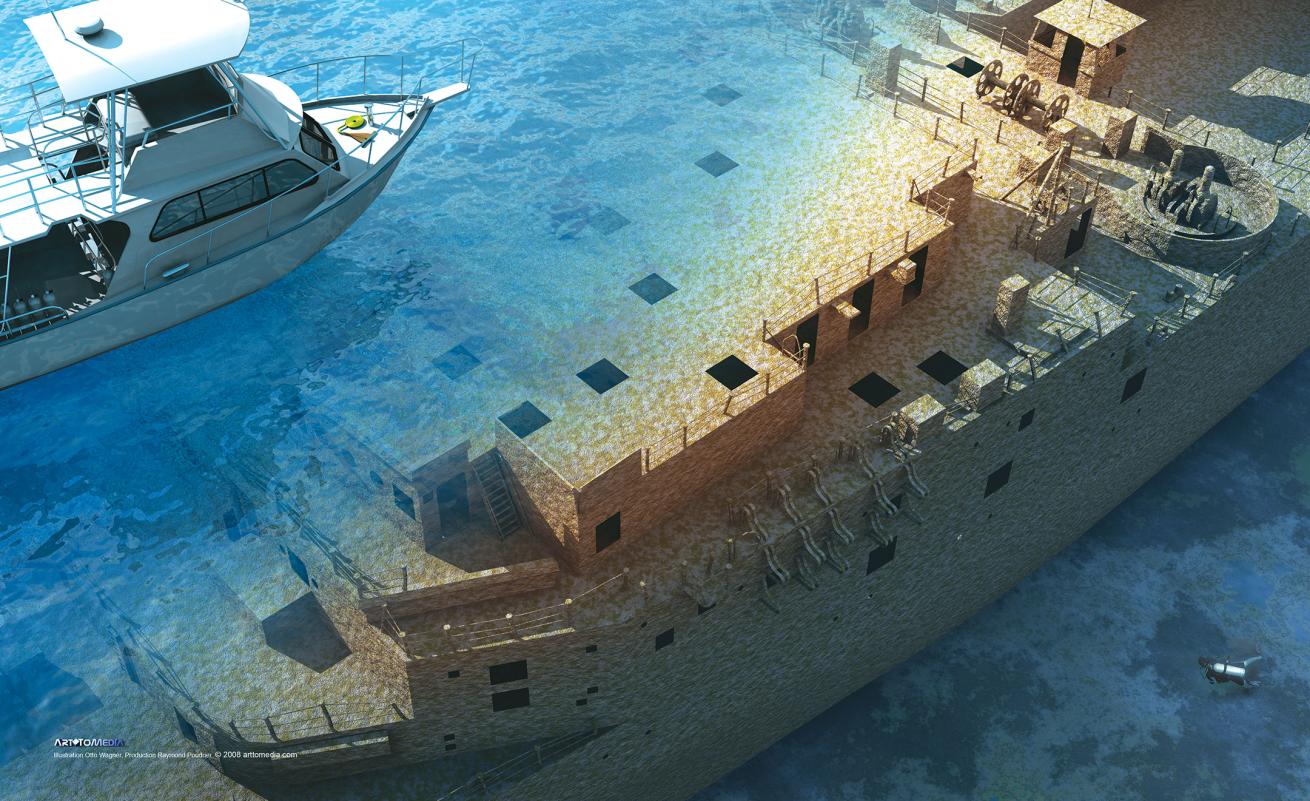
Art To MediaYou'll need to show proof of Advanced Open Water certification to dive the Spiegel Grove.
The feelings divers get from shipwrecks run the gamut from anticipation to nostalgia and downright awe. So it's no wonder a hearty diving business blooms anywhere you can find a good selection of diveable ships. But the unnatural nature of a shipwreck that makes them so attractive also makes them less accessible than your average reef. Deep, rough, current-swept waters are not the exception, they're the norm, and for this reason, many dive shops limit who can join their wreck charters. And they expect the divers who do make the cut to have a certain amount of confidence and skill with the diving techniques often necessary for wreck diving. You can see what's expected of a diver on a more-advanced wreck site in this step-by-step guide to diving the Spiegel Grove, which lies offshore of Key Largo, Fla.
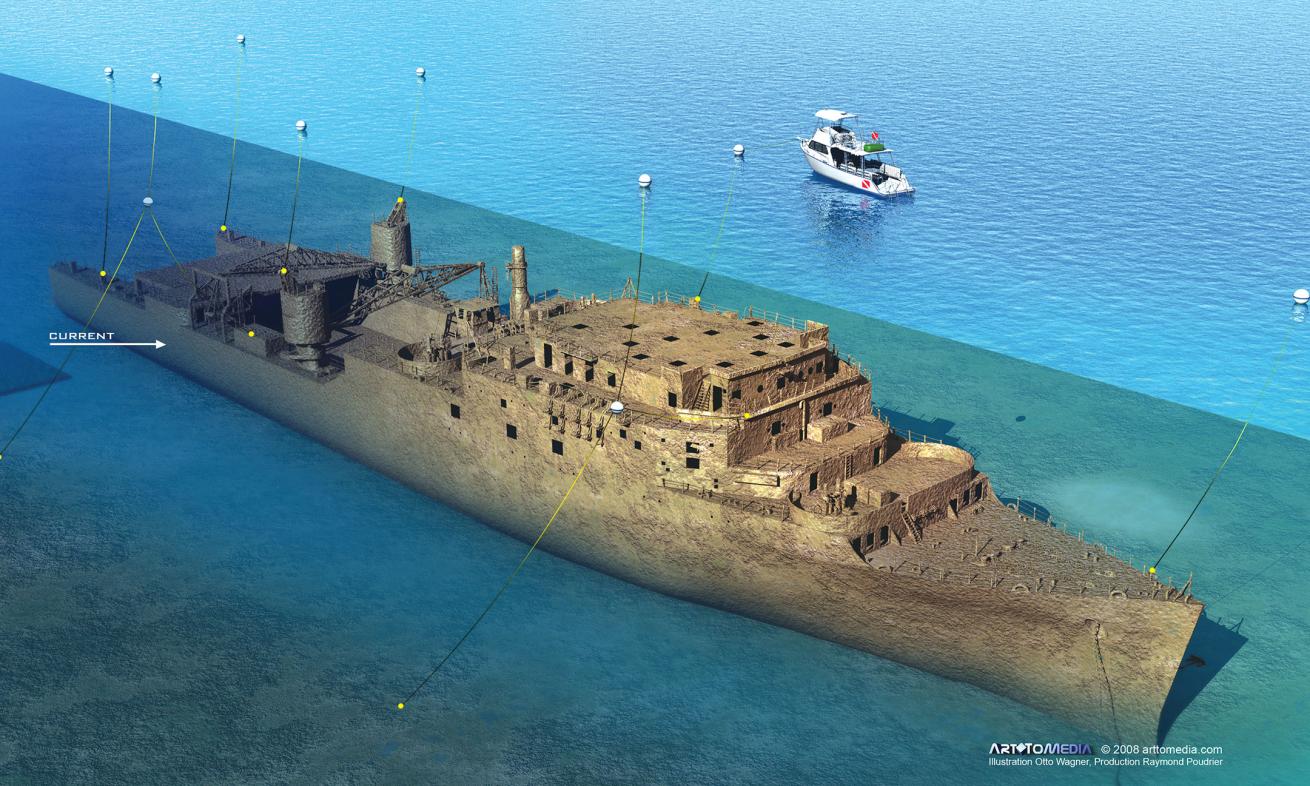
Art To MediaThe Spiegel Grove is massive — where you dive will depend on where your dive boat ties off.
Experience Required
Most wrecks are advanced dives, and dive operators will often want to make sure you're comfortable with deep dives and less-than-perfect conditions before they'll sign you up. An advanced-open-water certification or a logbook showing a recent history of similar dives will usually get you an OK. Some operators may require divers to do a shallow-water reef trip before an advanced wreck charter as a checkout dive. Or if you're a beginning or out-of-practice diver who needs a little help, you can usually hire one of the shop's divemasters to guide you and help keep you safe on these advanced dives.
The Boat Ride Out
Wrecks often lie in open water — the Spiegel Grove is six miles offshore — so the chances of rough seas are decent. Set up your gear before leaving the dock or early on in the trip out so you're not fumbling on a bouncing deck at the site. Put your wetsuit on halfway, as well as your boots if you have them, stow your gear bag somewhere out of the way, place your mask, fins and any other equipment you'll need on the dive under the bench at your tank. If you don't already have a buddy, talk to the divemaster after the boat briefing to make sure you know whom you're diving with. Then get together and take advantage of the drive time to discuss your dive plan.
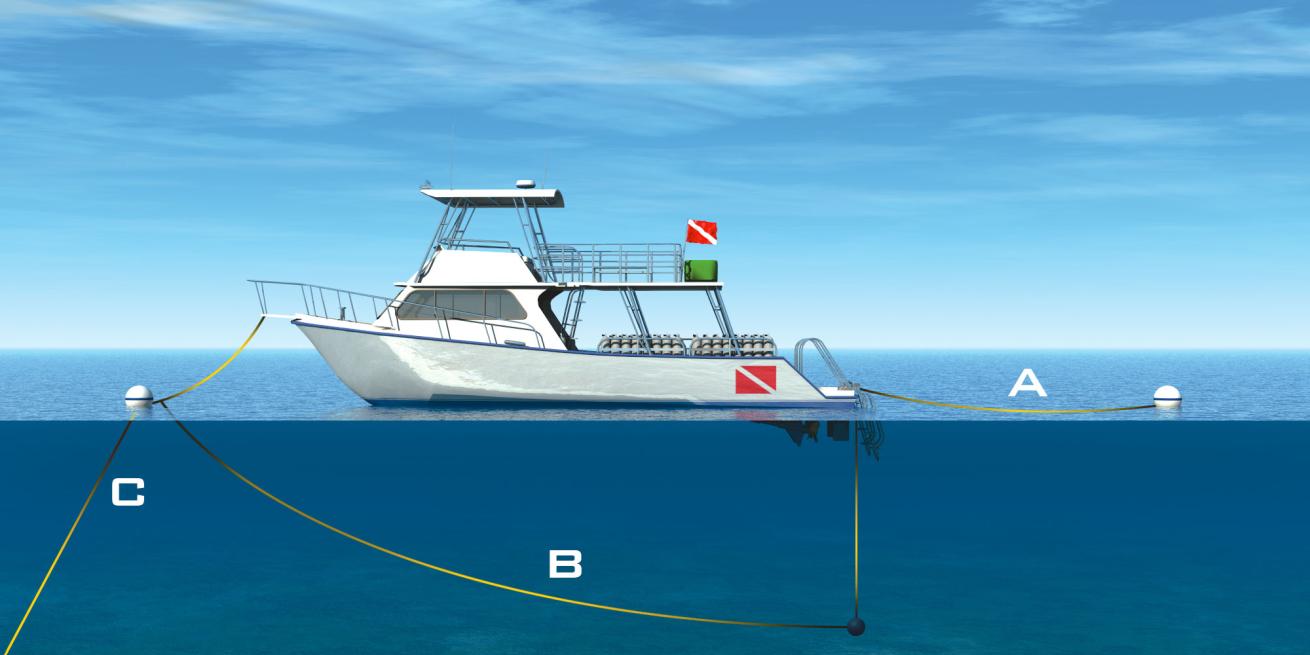
Art To MediaDue to current, your dive operator will use a trail line and "granny" line to make it easier for you to get to the mooring line.
Getting In and Down
The most difficult entries take place in a combination of current and heavy seas, and trying to descend without a line in a stiff current is a good way to get swept away. Most boats use a combination of the following lines to get you from the stern of the dive boat to the deck of the shipwreck.
Trail line This has one end tied to the stern with about 50 feet of line tossed out behind the boat and a float attached to the other end. The current will carry the float out behind the boat so divers will have a line to hold onto when they jump in.
Tagline AKA a granny line, this runs from the stern of the boat to the mooring line. There are two setup variations. The more common runs along the water's surface. The second, often used in rough conditions, is a weighted descent line on the stern of the dive boat with the tagline also attached to the weight and running to the mooring underwater.
Mooring line This is the divers' lifeline between the dive boat and the shipwreck. Always start and end the dive here.
Equipment-donning procedures vary among dive boats, so put your BC, mask and fins on according to the divemaster's instructions. Before moving to the entry point, put some air in your BC and your regulator in your mouth. Enter the water as instructed by the crew as soon as you get to the entry point — a swim step is a precarious place to stand in rough conditions. Once you've splashed, give an overhead OK, move swiftly away from the entry area and grab the trail line so you don't drift in the current.
Once you and your buddy are both in the water and ready to go, use the trail line to pull yourself to the tagline, avoiding the entry area as much as possible. If the current is fairly strong, be sure to never let go of one line without first grabbing another. In this way move yourself to the tagline and pull your way toward the bow. If the boat is swinging, be careful of the hull as you move alongside — holding the tagline and swimming slightly away from the dive boat can help you keep your distance. Once you've made it to the mooring line, hold it with one hand (gloves are a good idea as hydroids, barnacles and fibers from the rope can irritate your hands), and dump your air with the other. Stay with your buddy and go hand-over-hand down the mooring until you get to the wreck.
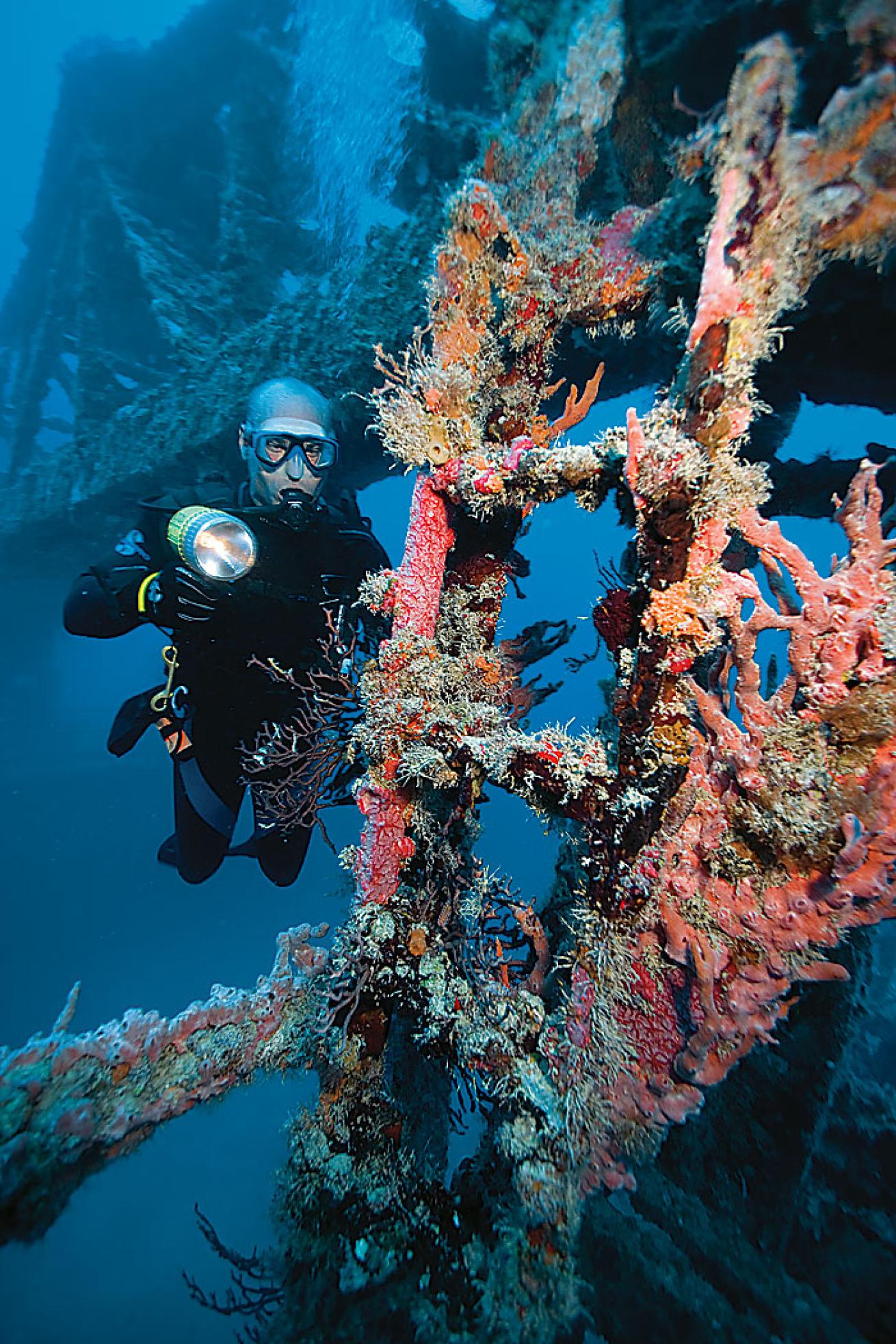
Stephen FrinkThe current typically approaches from the south, hitting the starboard corner of the stern and flowing diagonally across the ship. Stay close enough to the wreck that you don't get swept away.
Getting Around
Mark your starting point • On the Spiegel Grove, you'll notice that some of the mooring lines split in two directions. The line with the steepest angle toward the bottom goes to the sand; the other line — identified by plastic blue marker arrows — will take you to the wreck. Not all wreck moorings are like this, but this is the type of information you should get from your divemaster before you go in. At the bottom, a lot of mooring points look similar, so before you leave your mooring, look around for features on the wreck you'll recognize on the way back. Many experienced divers even bring a small length of brightly colored line to tie on or near their mooring line for positive identification at the end of the dive. Avoid plastics. And be sure to remove the marker on your way back to the surface.
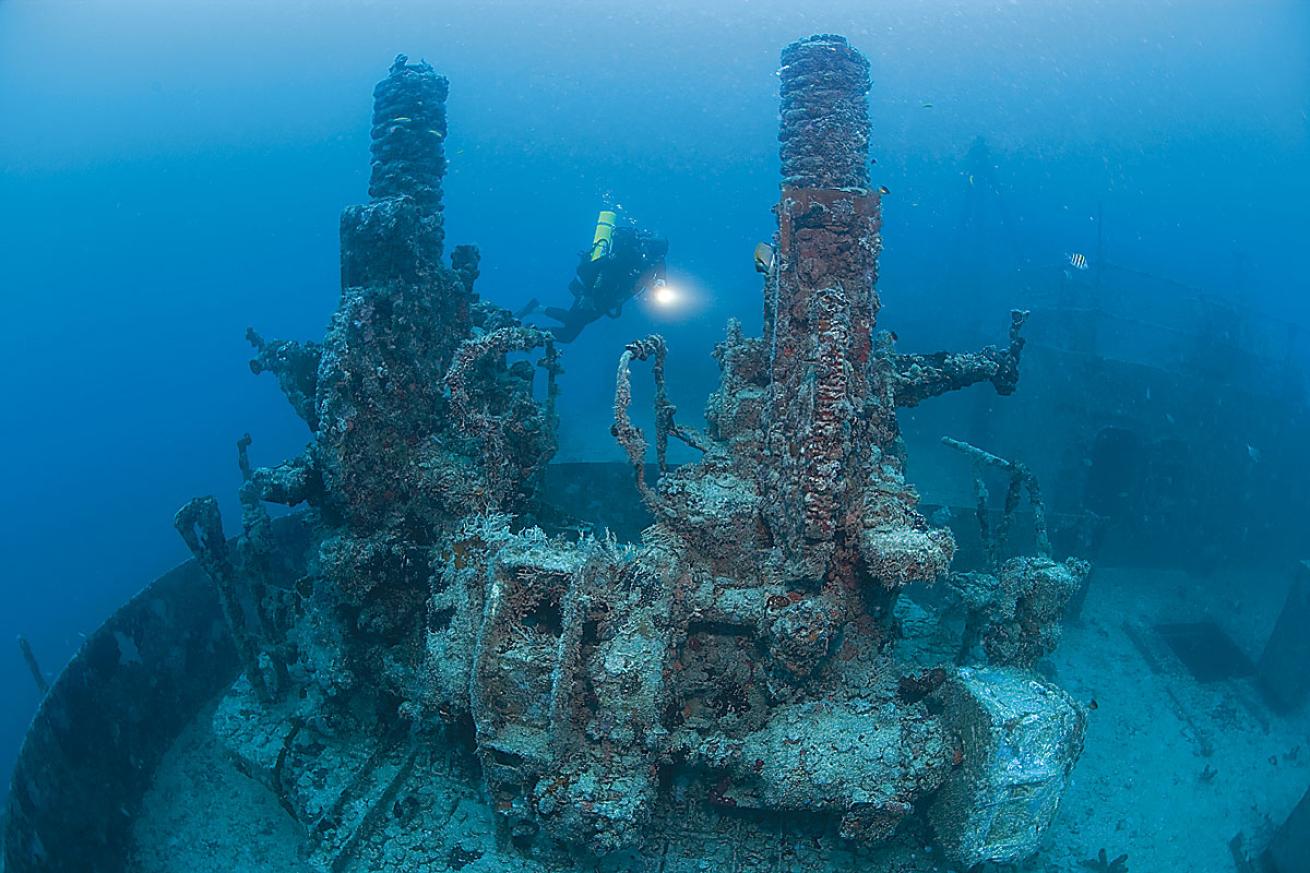
Stephen FrinkStay with your buddy and go hand-over-hand down the mooring until you get to the wreck.
Know the current Most wrecks lie in open ocean where currents rip more often than not. Find out from the divemaster, or by watching the boat's trail line, the general direction of the current and incorporate that into your dive plan. Also, realize that currents can change quickly anywhere, so always take note of the current's direction once you're on the wreck, and plan your dive conservatively in case it changes during the dive. Once you arrive on the wreck, you can actually use the current as a tool in many cases by turning your dive up current from your exit point. Use the wreck to your advantage by staying on the leeward side or ducking behind towers or equipment on the deck that will provide a buffer for the flow as you swim away from the mooring line. Then explore the current-swept parts of the wreck as you let the current propel you back to your exit point at the end of the dive. Just be sure to stay close enough to the wreck that you don't get swept away.
On the Spiegel Grove, the current typically approaches from the south, hitting the starboard corner of the stern and flowing diagonally across the ship. When the current approaches from this direction, you can dive the rear of the superstructure by using the cranes and other equipment on the deck to protect you from the brunt of the current. This equipment will catch most of the flow and push it up over the top of the ship, so duck down low to the deck to stay out of it. The current will be strongest along the starboard side of the wreck because when the flow hits the back corner of the ship, it flows like a river down the smooth side towards the bow. The port bow area and most of the port side of the superstructure is in the lee, protected from the flow, making these much more relaxing areas to dive.
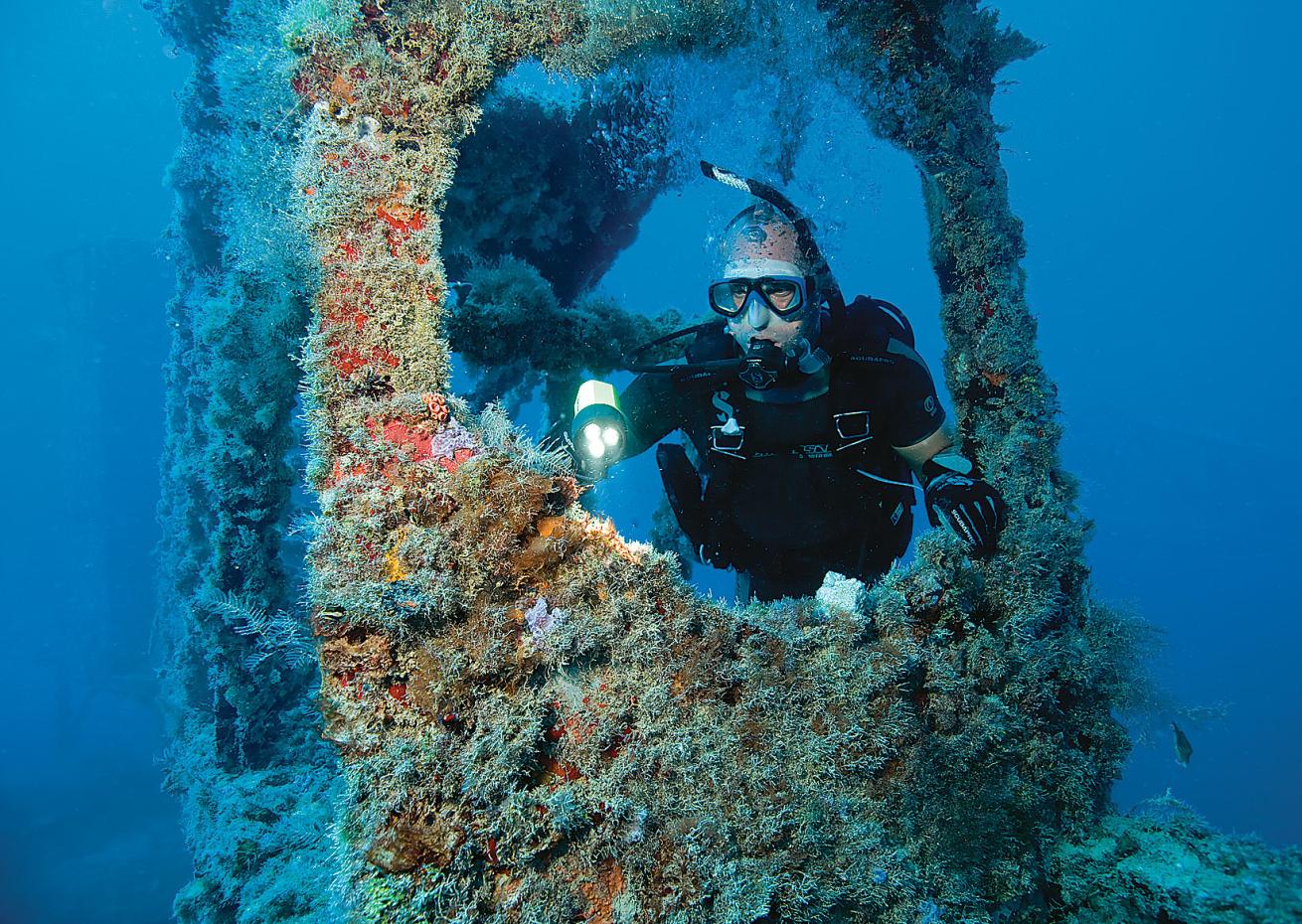
Stephen FrinkThe Spiegel Grove has a healthy coating of marine life.
Going inside? The great allure for many wreck divers is not swimming the decks. The interiors of these ships offer a three-dimensional experience filled with history and excitement — and a lot of risk. Closed rooms and passageways shouldn't be penetrated unless you have the proper training. Most wreck fatalities — around 92 percent — happen within 50 feet of the exit, so even if it seems like there's plenty of light coming through the entrance, don't go in unless the water inside is clear and you physically see the exit on the other side — for example, wide-open rooms or hallways that are open on both ends. And if you are going to penetrate these areas, look around first and think three-dimensionally while you do it. Look up to make sure you don't swim beneath fishnets, dangling lines or rigging that can entangle your tank valve or other pieces of equipment.
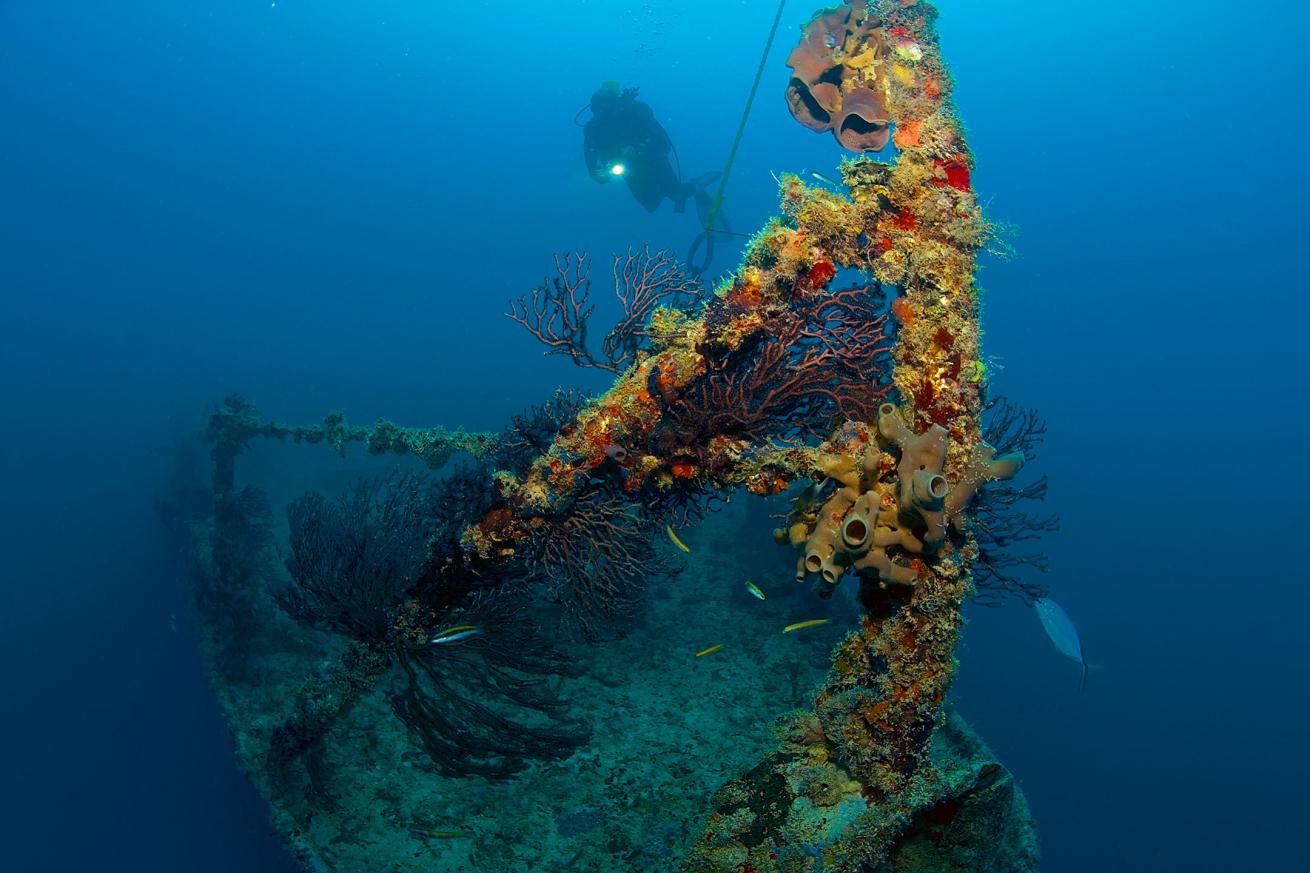
Stephen FrinkThe Spiegel Grove offers endless exploration opportunities even if you're not trained in wreck penetration.
Here are the dos and don'ts of light penetration:
Never enter the wreck with less than two-thirds of your air supply.
The water inside the structure should be clear and you should see daylight clearly at the exit — even before you enter the passage.
Never swim into areas that will keep you in the overhead environment for more than 40 or 50 feet (unless of course you have the proper training and equipment for wreck penetration).
Never swim through areas where you and your buddy cannot swim side by side.
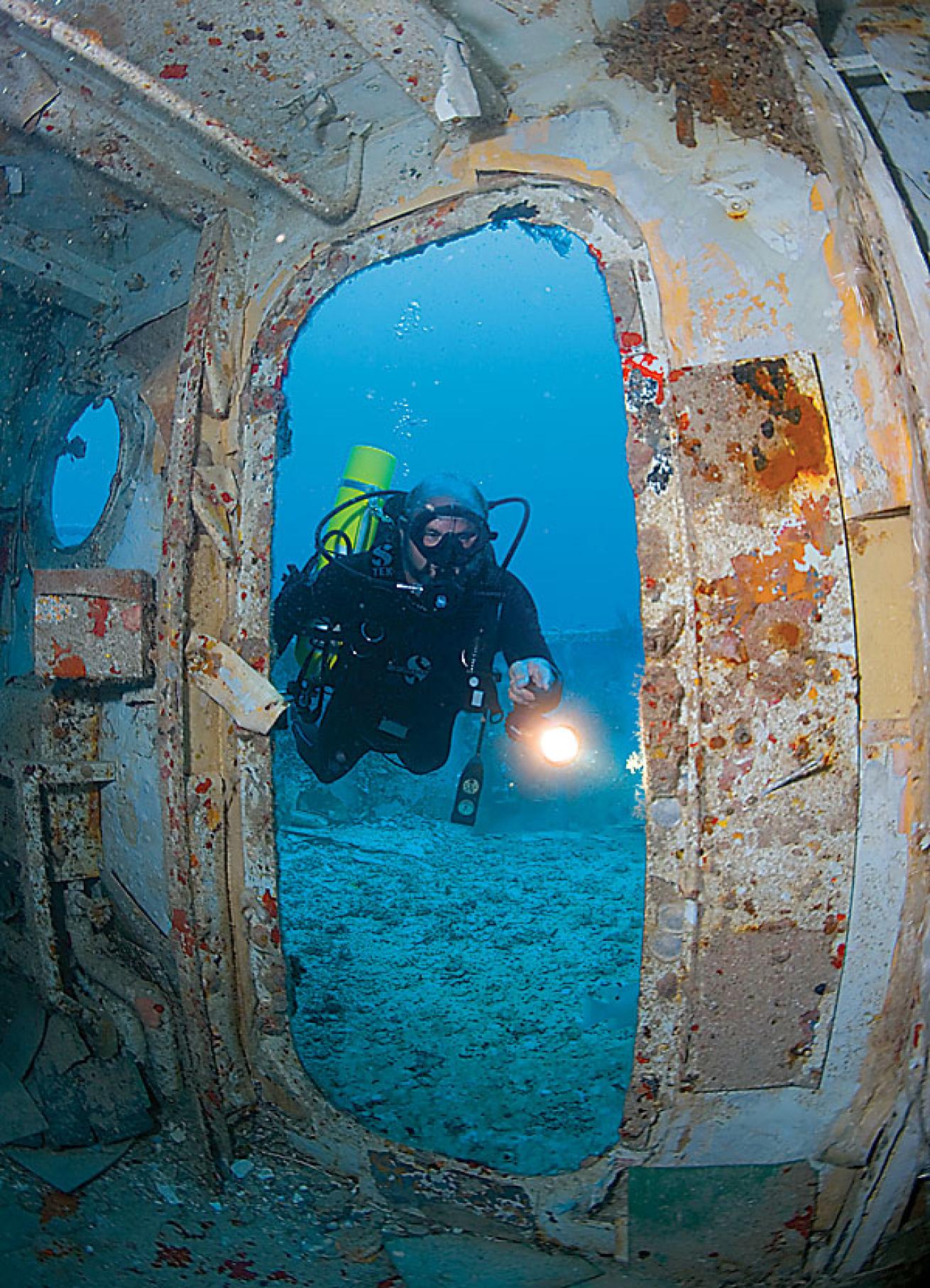
Stephen FrinkNever enter any opening into a wreck unless you have the proper training and gear.
The Spiegel Grove's bridge, which you'll find at the forward part of the superstructure, is one of these simple linear swim-throughs, and it's relatively safe for recreational divers to penetrate. Look through the passageway, and you'll clearly see the opposite opening. Once you swim inside, you'll see two companionways running aft from the bridge. It's tempting to enter side passageways like these. Avoid the temptation. Again, if you really want to see the deep, dark bowels of shipwrecks, learn to do it properly with a reputable training agency. If you're not keen on penetrating wrecks, no worries, you can always just stick your head inside and take a look.
Getting back to the mooring Two factors should limit your wreck dives: the no decompression limit and your available air supply. Manage both using the rule of thirds. You should use a third of your available time limit or air — whichever comes first — to swim away from your exit point, a third to return to the exit point and a third for delays or emergencies. If you plan your dive around the wreck's key structures, use the current to your advantage and limit your dive to a reasonable range, you should have no problem reaching the mooring line ahead of schedule with seven to eight minutes of no-decompression and useable air time remaining. Once you make it back to your starting point, use any remaining time to explore around the mooring, keeping the mooring line clearly in sight until it's time to go up.
Safety Stops
As you approach the 15-foot mark, you should make a safety stop for three to five minutes. This can be a little challenging on a crowded boat if there are a lot of divers hanging on the line at the same time. The goal is to be around 15 feet, but most experts agree that anywhere from 10 to 20 feet is acceptable, so you can spread out within that depth range. On a crowded safety stop, many advanced divers will use a short length of line called a jon line to move away from the actual mooring while still maintaining contact. These are usually between six and 10 feet long, with a clip that slips around the boat's mooring line and locks into place so a diver can back away, leaving space for other divers.
Once you've completed your safety stop, surface and use the tagline to move to the dive boat's stern, or just let the current take you to the trail line. Once you grab the trail line, continue down current so you're out of the exit area, inflate your BC and wait for your turn to exit.
Getting Back Aboard the Dive Boat
In rough conditions, this can be one of the most dangerous parts of the dive. It's best to keep your regulator in your mouth and your mask firmly on your face until you're aboard the boat and away from the entry area. Some vessels have fins-on boarding ladders that let divers climb the ladder and kneel on the swim platform before removing their fins to walk across the boat's deck. If your boat doesn't have this type of ladder, remove your fins before climbing up. The larger the swells, the more the boat will move up and down, and it is very easy to get struck by the ladder or platform while approaching the boat or removing your fins. Deflate your BC, and approach when the boat is at the bottom of a swell. Get a firm grip on the ladder, reach down and remove each fin by crossing one leg over the knee of the other leg and removing the fin with one hand while hanging onto the ladder with the other. Once each fin is off, slip your hand through the strap, pulling the fin onto your arm so that you have it should you fall back into the water or lose contact with the boat. If you dive in full-foot fins, you'll have to hand the fins up to a crewmember as you remove them. If you lose contact with the boat, immediately put your arms up between your body and the vessel, drop down and swim away from the boat, resurfacing behind it. If you deflate your BC before approaching the vessel, and keep your reg in your mouth, descending should be easy, and even if the boat strikes your arms, it will simply push you down in the water column. Once you're on board, move immediately to your seat and secure your tank and other equipment.
Wreck Tips
Damage Control If you get swept off the line during your descent, you'll have to make a snap decision. If you are close enough to the wreck that you can rapidly descend to the protection its structure affords from the current, you can complete your dive. Just be sure that your buddy comes with you. If you can't make it to the wreck, you'll need to do a controlled but immediate ascent. On the surface, get positively buoyant and immediately deploy your surface-signaling device to alert the crew before you're swept out to sea.
Less Is More
Remember, it's impossible to adequately cover a large wreck in a single dive, even in relatively shallow water. Rushing to swim the wreck's entire circumference often won't give you enough time to really explore any one area. It's best to stay within a few hundred feet of the exit point — even closer on deeper dives.
Grove At A Glance
Location: Dixie Shoals, off Key Largo, Fla.
Length: 510 feet
Beam: 84 feet
Depth Range: 60 to 134 feet
Best Time to Dive: May to September










